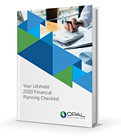How to Use Inflation to Your Advantage
By Jesse Giordano, CFP® | July 29, 2021Headlines have been swirling around all the ways inflation could impact investors and consumers. In June, inflation had increased by 5.4% from a year earlier; the biggest 12-month jump since August 2008, according to the Bureau of Labor Statistics “all items” index. That far outpaces the Federal Reserve’s target rate of inflation, which is 2%.

But before you panic, it’s important to understand that inflation provides governments with the opportunity to rightsize their national debt. When viewed through this lens, it’s possible to use inflation to your advantage. Staying ahead of inflation comes down to putting your money to work in the right places—and giving it time to compound your returns.
The Link Between Inflation, National Debt and GDP
Inflation isn’t something people generally welcome, especially when retirement planning. But the truth is that the United States actually needs it. The reason comes back to our national debt, which has risen sharply globally since 2008. In 2021 alone, the federal budget deficit is projected to reach $3.4 trillion.
The size of the national debt itself isn’t the issue. How it relates to our annual total economic output (measured by GDP) is what matters most. The U.S. has the most debt in the world, with the total being equivalent to 107% of GDP. Paying down this kind of growing debt often comes at a social cost—raising taxes or cutting spending. If the U.S. is unwilling to take these measures, how do we course-correct?
The answer is inflation. Reducing the value of the dollar serves to inflate GDP. In other words, GDP grows but with less purchasing power. It’s a viable option for getting the national debt at or below 80% of GDP, though it could take a couple of decades to get there. If inflation is 2%, we would likely cross the finish line in 20 years, which is too long of a timeline. However, if it hovers around 3%, we could accomplish it in 11 years, providing we don’t have any major economic crises between now and then.
Other Potential Effects of Inflation
In addition to rightsizing national debt as it relates to GDP, inflation is also a way to tax dormant money held in cash, CDs and bonds. Unfortunately, the working class tends to feel the brunt of inflation because their wages don’t rise fast enough to keep up with rising costs. Apart from that, consumers who provide money to lend by way of CDs and bonds are also impacted by inflation. Over time, they will be paid back with dollars that won’t buy as much as they do today. In this way, inflation is a roundabout way of taxing the wealthy who hold money in fixed assets without needing an act of Congress.
Currency devaluation can also be used as an economic weapon. During the Cold War, the U.S. forced the dollar up to push oil prices down. This directly impacted the Soviet Union, making it impossible for them to keep up with U.S. military expenditures. Today, the U.S. can take the reverse strategy of devaluing the dollar, which could significantly hurt Chinese exports.
What This All Means for Investors
It’s a lot to digest, but the most important thing is how all of this will affect investors. For one, we can expect interest rates to will remain artificially low for some time. (Low interest rates tend to spur more inflation.) From an investment standpoint, bonds, CDs and fixed-interest investments may fall behind inflation. But as a borrower, you could consider taking advantage of low rates and put your money to work when appropriate.
You can also expect the following:
- Changes to retirement planning: Investors who are looking to maintain purchasing power through retirement will likely have to get comfortable with holding stocks in order to keep pace with inflation. While riskier than bonds, stocks have historically rendered better returns. They also tend to advance with inflationary times, particularly with high cash-paying investments like dividend stocks. This is because they can put cash in your hands now. That’s not to say that bonds are irrelevant—they’re still a necessary part of a balanced portfolio that protects against market volatility. We just need to start thinking differently about how we use them. The main takeaway is that it’s wise to adjust your spending assumptions when retirement planning.
- Revised overall investment strategies: As the dollar continues to devalue, non-dollar investments will become more attractive, but it’s smart to be selective. Commodity investing has become popular, but we recommend investing in businesses that work with the commodity as opposed to the commodity itself (e.g., gold mining companies instead of actual gold).
You may also want to shift your focus away from the overcrowded landscape of public companies. For qualifying investors, devoting more attention to alternative investments can allow for better risk management, greater diversity, and a stronger upside to offset the costs of inflation. Meanwhile, use caution when investing in speculative ideas like Bitcoin or special-purpose acquisition companies (SPACs), which can be tempting but risky.
The bottom line is that inflation will play a role over the next decade, but it’s nothing to fear. It’s simply a way for the U.S. to bring the national debt into appropriate balance with GDP. Being aware of it, and modifying your investment approach accordingly, can put you on the right side of inflation.
With that said, timing is everything. To make the most out of compound interest, it needs time. As Benjamin Franklin famously said, “Money makes money. And the money that money makes, makes money.” The time to start is always now. Contact an Opal advisor today to learn how you can use inflation to your advantage.
Be a Smart Investor
Stay up-to-date with industry-leading information and news delivered straight to your inbox.
Get our timely insights delivered to your inbox (Blog)
Please remember that past performance may not be indicative of future results. Different types of investments involve varying degrees of risk, and there can be no assurance that the future performance of any specific investment, investment strategy, or product (including the investments and/or investment strategies recommended or undertaken by Opal Wealth Advisors, LLC [“OWA]), or any non-investment related content, made reference to directly or indirectly in this commentary will be profitable, equal any corresponding indicated historical performance level(s), be suitable for your portfolio or individual situation, or prove successful. Due to various factors, including changing market conditions and/or applicable laws, the content may no longer be reflective of current opinions or positions. Moreover, you should not assume that any discussion or information contained in this commentary serves as the receipt of, or as a substitute for, personalized investment advice from OWA. OWA is neither a law firm, nor a certified public accounting firm, and no portion of the commentary content should be construed as legal or accounting advice. A copy of the OWA’s current written disclosure Brochure discussing our advisory services and fees continues to remain available upon request or at www.opalwealthadvisors.com. Please Remember: If you are a OWA client, please contact OWA, in writing, if there are any changes in your personal/financial situation or investment objectives for the purpose of reviewing/evaluating/revising our previous recommendations and/or services, or if you would like to impose, add, or to modify any reasonable restrictions to our investment advisory services. Unless, and until, you notify us, in writing, to the contrary, we shall continue to provide services as we do currently. Please Also Remember to advise us if you have not been receiving account statements (at least quarterly) from the account custodian.



